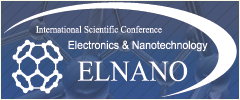Feed aggregator
День італійського дизайну в Україні пройде в Київській політехніці!
Про плани проведення заходу під час візиту до нашого університету розповів Карло Колоннелла, директор Італійського інституту культури в Києві при Посольстві Італії в Україні, та Паоло Коя, дизайнер і архітектор, організатор Дня італійського дизайну.
Вітаємо Михайла Захаровича Згуровського із 75-річчям
Сьогодні своє 75-річчя відзначає Згуровський Михайло Захарович — доктор технічних наук, професор, академік НАН України, міністр освіти України (1994–1999 рр.), ректор Київської політехніки з квітня 1992 по липень 2024 року.
Infineon introduces new EiceDRIVER isolated gate driver ICs for traction inverters in electric vehicles
Infineon Technologies AG introduces new isolated gate driver ICs for electric vehicles to enhance its EiceDRIVER family. The devices are designed for the latest IGBT and SiC technologies. Furthermore, they support Infineon’s new HybridPACK Drive G2 Fusion module, the first plug’n’play power module that implements a combination of Infineon’s silicon and silicon carbide (SiC) technologies. The pre-configured third-generation EiceDRIVER products, 1EDI302xAS (IGBT) and 1EDI303xAS (SiC/ Fusion), are AEC-qualified and ISO 26262-compliant, ideal for traction inverters in cost-effective and high-performant xEV platforms.
The devices 1EDI3025AS, 1EDI3026AS and 1EDI3035AS provide a strong output stage of 20 A and drive high-performance inverters of all power classes up to over 300 kW. The variants 1EDI3028AS and 1EDI3038AS with an output stage of 15 A are ideal for use in entry-level battery electric vehicle (BEV) and plug-in hybrid electric vehicle (PHEV) inverters as well as for the excitation circuit of externally excited synchronous machines (EESM). In addition, the devices are equipped with the new tunable soft-off feature, which provides excellent short-circuit performance to support the latest SiC and IGBT technologies.
Various monitoring functions, such as an integrated self-test for desaturation protection (DESAT) and overcurrent protection (OCP), improve the handling of latent system errors while the new primary and secondary safe-state interface enables versatile system safety concepts. In addition, a continuously sampling 12-bit delta-sigma ADC with integrated current source can read the voltage directly from temperature measurement diodes or an NTC. The gate drivers also provide reinforced insulation according to VDE 0884-17:2021-10 to enable safe isolation following standardized qualification and production testing procedures. Furthermore, the compact package (PG-DSO-20) and excellent compatibility with the latest power stage technologies help customers to drive system integration and reduce design cycle times.
AvailabilityThe new EiceDRIVER isolated gate driver ICs for EV (1EDI3025AS, 1EDI3026AS, 1EDI3028AS, 1EDI3035AS, 1EDI3038AS) can be ordered now and samples are available. More information is available at www.infineon.com/eicedriver-xev.
The post Infineon introduces new EiceDRIVER isolated gate driver ICs for traction inverters in electric vehicles appeared first on ELE Times.
Semiconductors for Faster and Smaller Electronics in India
Semiconductors are the backbone of modern electronics, enabling faster, smaller, and more power-efficient devices. As India moves towards becoming a global hub for semiconductor manufacturing and design, the demand for cutting-edge chip technology is rising. The integration of advanced fabrication techniques, AI-driven chip design, and the push for indigenous semiconductor production are set to transform India’s electronics ecosystem.
The Need for Faster and Smaller ElectronicsThe electronics industry is driven by the demand for compact and high-performance devices, including smartphones, wearables, automotive electronics, and IoT devices. Key trends pushing the semiconductor industry forward include:
- Moore’s Law Advancements: Continuous scaling down of transistor sizes following the path of Extreme Ultraviolet Lithography (EUVL) for enhanced patterning precision and increased transistor density.
- AI and Edge Computing: Implementation of neuromorphic computing architectures using emerging materials like Resistive RAM (ReRAM) and Phase-Change Memory (PCM).
- 5G and Beyond: Deployment of compound semiconductors such as Gallium Nitride (GaN) and Indium Phosphide (InP) for high-frequency, high-power RF applications.
- Energy Efficiency: Adoption of tunnel field-effect transistors (TFETs) and spintronic devices for ultra-low-power computing.
With the shift to 5nm, 3nm, and upcoming 2nm process nodes, semiconductor manufacturers are pushing the limits of physics. These smaller nodes provide:
- Increased effective channel mobility by integrating high-k metal gate (HKMG) stacks and strained silicon engineering.
- Improved electrostatic control over transistors through stacked nanosheet transistors.
- Higher integration density through Self-Aligned Quadruple Patterning (SAQP).
- FinFET (Fin Field-Effect Transistor) technology dominates sub-10nm nodes, offering superior gate control through multi-gate designs.
- GAAFET (Gate-All-Around FET) represents the next evolution, transitioning towards nanosheet transistors, reducing leakage currents and enhancing threshold voltage tuning.
- 3D stacking (TSV – Through-Silicon Via) allows for vertical integration, minimizing signal propagation delays and interconnect parasitics.
- Chiplet-based designs using advanced heterogeneous integration enable diverse functional blocks to be assembled with high-bandwidth interconnects such as UCIe (Universal Chiplet Interconnect Express).
India is aggressively pushing for semiconductor self-sufficiency through initiatives like Semicon India Program and partnerships with global leaders. The focus areas include:
- Domestic Fab Development: India is investing in semiconductor fabs with partnerships involving TSMC, Intel, and GlobalFoundries.
- Design and IP Development: Indian startups and research institutions are working on AI-powered EDA (Electronic Design Automation) tools leveraging machine learning for physical design optimization.
- Material Advancements: R&D in wide-bandgap semiconductors like SiC (Silicon Carbide) and GaN (Gallium Nitride) for high-efficiency power electronics.
- ISMC Analog Fab: A proposed semiconductor fab with Israeli collaboration focusing on mixed-signal and RF chip manufacturing.
- Vedanta-Foxconn JV: Focused on setting up a 28nm technology node semiconductor fab in India.
- Tata Electronics: Exploring advanced semiconductor packaging and system-in-package (SiP) solutions.
- India Semiconductor Mission (ISM): A government-backed initiative to accelerate semiconductor fabrication, design, and advanced packaging capabilities.
While India is making significant strides in semiconductor manufacturing, challenges remain:
- Supply Chain Dependencies: Reliance on foreign suppliers for high-purity silicon wafers and photolithography tools.
- Skilled Workforce: Need for specialized talent in quantum computing, cryogenic electronics, and advanced packaging.
- High CAPEX Requirements: Semiconductor fabs require multi-billion-dollar investments with long ROI cycles.
Despite these challenges, India’s semiconductor sector is set to grow rapidly with government support, strategic partnerships, and technological innovations. The move towards faster, smaller, and more efficient semiconductors will drive India’s electronics industry forward, making the country a key player in the global semiconductor race.
ConclusionThe evolution of semiconductors is enabling smaller, faster, and more efficient electronics, shaping the future of computing, connectivity, and automation. With India’s push towards self-reliance in semiconductor manufacturing and the adoption of next-gen technologies like AI-driven chip design, 3D stacked transistors, and advanced node fabrication, the country is poised to become a global semiconductor powerhouse. As investments grow and expertise expands, India’s role in the semiconductor revolution will only strengthen, paving the way for a digitally empowered future.
The post Semiconductors for Faster and Smaller Electronics in India appeared first on ELE Times.
Amtech Shares Key Trends Shaping the Future of Electronics Manufacturing in 2025
Amtech Electrocircuits, a leading provider of manufacturing solutions, is proud to present insights into the key trends driving innovation and growth in 2025. From advanced automation and sustainability to AI integration and supply chain diversification, these trends are setting the stage for the next era of manufacturing excellence.
“These emerging trends align closely with our mission to deliver cutting-edge solutions that enhance efficiency, sustainability, and resilience across the electronics manufacturing industry,” said Jay Patel, CEO at Amtech. “Amtech is here to help our partners seize new opportunities and drive success in 2025 and beyond.”
Top Trends to Watch in 2025:- AI and Machine Learning Integration: Transforming processes like predictive maintenance, automated quality control, and production optimization, AI is enhancing efficiency and reducing downtime across the industry.
- Advanced Automation and Robotics: Collaborative robots (cobots) and lights-out manufacturing are revolutionizing production by enabling autonomous, high-throughput operations with minimal human intervention.
- Reshoring and Regionalization: Companies are prioritizing local manufacturing to mitigate global uncertainties and build resilient supply chains with faster lead times.
- Sustainability and Circular Economy: Greener practices, energy efficiency, and resource recycling are driving the shift toward a circular economy, ensuring environmental and economic benefits.
- Smart Manufacturing and IoT: Real-time data from interconnected devices in smart factories is powering predictive analytics and better decision-making, elevating productivity and quality.
- Additive Manufacturing (3D Printing): Moving beyond prototyping, 3D printing is enabling the production of complex components with reduced waste, particularly in high-value sectors like aerospace and medical devices.
- High-Mix, Low-Volume Production: Flexible production systems are meeting the growing demand for customized solutions without compromising efficiency or quality.
- Enhanced Cybersecurity Measures: With connected systems comes the need for robust cybersecurity to protect sensitive data and ensure operational integrity.
- Workforce Transformation: Upskilling employees to work alongside advanced technologies and addressing labor shortages through automation are reshaping the manufacturing workforce.
- Global Supply Chain Diversification: Exploring alternative sourcing strategies and partnerships is critical to building supply chain resilience and agility.
Amtech is dedicated to supporting its customers as they navigate these trends and transform their operations. With innovative solutions tailored to high-mix, low-volume production, sustainability initiatives, and smart manufacturing technologies, Amtech helps businesses embrace change and position themselves as industry leaders.
The post Amtech Shares Key Trends Shaping the Future of Electronics Manufacturing in 2025 appeared first on ELE Times.
Finally complete. Did some last minute fault debugging and tried to reinforce the frame supporting the components and sent it off to Hawaii
 | Right before I packed up the device to get it mailed out, a fault showed up in the hours section where one of the hours nixie was displaying a 0 and a 6 at the same time, ended up doing last minute debugging, reinforcing the frame supporting the components, adjusted the wires on the 5vdc power rail to prevent shorts, etc. Mailed the device out yesterday, and am waiting on bated breath that the thing shows up in Hawaii in working order. Fingers crossed! At any rate, based on some questions on my original post, some people wanted the schematics to this clock. I tried to scan the schematic as an image and will post it here for reference. Note that the microcontroller came preprogrammed and I don’t have the source code. The most important thing is the BCD decoder and nixie drivers. You can use any generic MPU or controller you want. In this implementation, the only inputs to the BCDs are the serial clock (SCK), receive clock (RCK), and serial data (SI) for each hour and minutes display. Serial clear (SCLR) are tied hi to 5v rail, and the output enable (G) is tied low to ground, basically always keeping the outputs enabled to the nixie driver. There are many many things you can do with a 8bit BCD; a nixie clock is one of those things. For this implementation, you’d just have to write a program for your favorite controller (arduino, esp32, etc) to provide the SCK, RCK, and SI signals (as per the timing diagram outlined in the HC595 data sheet) for each hours, minutes, and seconds of the nixie display. I also posted another picture of other clock kits I bought from AliExpress. I can’t stop buying shit from that place. It’s like a drug lol. With that said, I really miss the clock I sent off to my grandpa, and I kinda want one for myself. So much so, that I’m planning to buy another kit from fecking AliExpress and give this another go to see if I can make this one better, or it’s still going to be ugly haha [link] [comments] |
DeepSeek’s AI stunner and the future of Nvidia

After the release of DeepSeek’s R1, a reasoning LLM that matches the performance of OpenAI’s latest o1 model, trade media is abuzz with speculations about the future of artificial intelligence (AI). Has the AI bubble burst? Is it the end of Nvidia’s spectacular AI ride?
EE Time’s Sally Ward-Foxton takes a closer look at the engineering-centric aspects of this talk of the town, explaining how DeepSeek tinkered with AI models as well as interconnect bandwidth and memory footprint. She also provides a detailed account of Nvidia’s chips utilized in this AI head-turner and what it means for Nvidia’s future.
Read the full story at EDN’s sister publication, EE Times.
Related Content
- Transform Your Business With AI
- AI at the edge: It’s just getting started
- Nvidia GTC 2024: Why Nvidia Dominates AI
- Is China Poised to Surpass the U.S. in Innovative AI Models?
- Project Stargate: Trump Announces $500 Billion of U.S. AI Infrastructure
The post DeepSeek’s AI stunner and the future of Nvidia appeared first on EDN.
BluGlass showcases new product capability for quantum applications at Photonics West
Back when my GTX 970 died, I decided to make use of the fans and heatsink.
 | submitted by /u/Ok-Violinist-765 [link] [comments] |
Renewable Power: TotalEnergies Will Supply 1.5 TWh to STMicroelectronics in France over 15 Years
- 1st PPA in France for STMicroelectronics, aiming at 100% renewable sourcing by 2027
- Power comes from 2 recent wind and solar farms of 75 MW operated by TotalEnergies
TotalEnergies and STMicroelectronics, a global semiconductor leader serving customers across the spectrum of electronics applications, have signed a physical Power Purchase Agreement to supply renewable electricity to STMicroelectronics sites in France. This 15-year contract, started in January 2025, represents an overall volume of 1.5 TWh.
TotalEnergies will provide STMicroelectronics with the renewable power (including the guarantee of origin) produced by two recent wind and solar farms of 75 MW operated by TotalEnergies. This power comes with structuration services to transform intermittent production in a constant volume (“baseload”) of green electricity. It’s the first time in France that such a 15-year contract is provided. The positive impact of the wind and solar projects on the environment and on the communities was a key success factor in the signing of the deal.
“We are delighted to sign this agreement with STMicroelectronics, which demonstrates our ability to provide long-term and innovative clean firm power solutions tailored to our customers’ needs,” said Sophie Chevalier, Senior Vice President Flexible Power & Integration at TotalEnergies. “TotalEnergies aims to be a preferred partner to support tech industry players towards their decarbonization efforts, and this agreement showcases our commitment and capabilities.”
“This first PPA in France marks yet another important step towards ST’s goal of becoming carbon neutral in its operations (Scope 1 and 2 emissions, and partially scope 3) by 2027, including the sourcing of 100% renewable energy by 2027,” said Geoff West, EVP and Chief Procurement Officer at STMicroelectronics. “PPAs will play a major role in our transition, and we have already signed several to support ST’s operations in Italy and Malaysia. Starting in 2025, this PPA with TotalEnergies will provide a significant level of renewable energy for ST’s operations in France, which includes R&D, design, sales and marketing and large-volume chip manufacturing.”
TotalEnergies and electricity
As part of its ambition to get to net zero by 2050, TotalEnergies is building a world class cost-competitive portfolio combining renewables (solar, onshore and offshore wind) and flexible assets (CCGT, storage) to deliver clean firm power to its customers. By mid-2024, TotalEnergies’ gross renewable electricity generation installed capacity reached 24 GW. TotalEnergies will continue to expand this business to reach 35 GW in 2025 and more than 100 TWh of net electricity production by 2030.
The post Renewable Power: TotalEnergies Will Supply 1.5 TWh to STMicroelectronics in France over 15 Years appeared first on ELE Times.
Forge Nano adds cleanroom, tripling ALD cluster tool production space
My home lab submission for workbench Wednesday
 | In honor of workbench Wednesday --- here is my home lab [link] [comments] |





